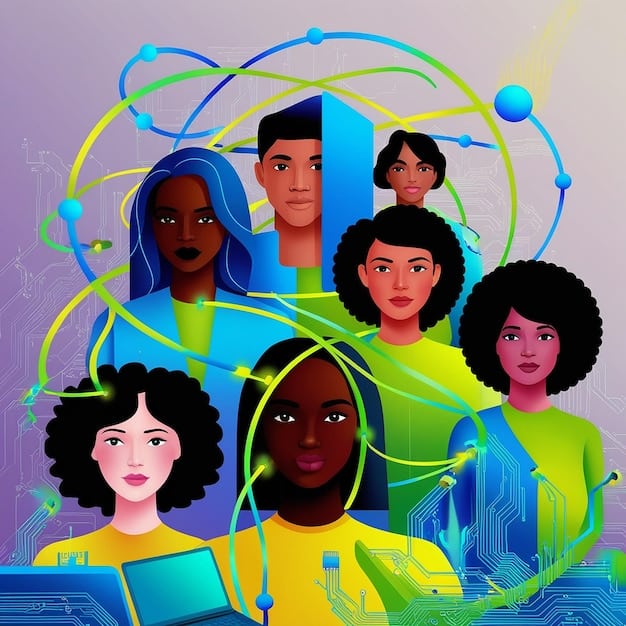Metaverse in US 2025: Ready for Mass Adoption?

Advertisements
By 2025, the metaverse may still be in its nascent stages for widespread consumer adoption in the US, facing significant hurdles in accessibility, interoperability, and compelling use cases beyond gaming and niche professional applications.
Advertisements
As we approach 2025, the landscape of digital interaction is rapidly evolving, with the concept of the metaverse in 2025: is it ready for mass adoption in the US? at the forefront of technological discussion. This immersive, interconnected digital realm promises to reshape how we work, play, socialize, and learn. Yet, its journey from futuristic vision to everyday reality is fraught with complex challenges and opportunities that warrant a closer look.
The Metaverse Vision: From Concept to Current Reality
The metaverse, often described as the next evolution of the internet, envisions a persistent, shared, 3D virtual space where users can interact with each other, digital objects, and AI-driven entities in a highly immersive manner. This goes beyond simple virtual reality or augmented reality by integrating a multitude of technologies, including blockchain, NFTs, artificial intelligence, and sophisticated networking infrastructure. The concept has been around for decades in science fiction, but recent technological advancements and significant investments from tech giants have propelled it into mainstream consciousness.
Advertisements
In its theoretical form, the metaverse offers a seamless transition between various virtual worlds, allowing users to carry their digital identities, assets, and experiences across different platforms. Imagine attending a virtual concert in one platform, then seamlessly moving to a business meeting in another, all while maintaining your unique avatar and digital possessions. This vision promises unprecedented levels of telepresence and interaction, potentially dissolving geographical barriers and creating new forms of economic activity.
From Theory to Practice: Early Ventures and Experimentation
Currently, what we refer to as the “metaverse” is a collection of disparate virtual platforms, each with its own ecosystem, rules, and user base. Platforms like Decentraland, The Sandbox, Roblox, and Fortnite have accumulated large user bases by offering varying degrees of immersive experiences, virtual economies, and user-generated content. However, these are largely siloed experiences, lacking the true interoperability and unified identity that characterizes a fully realized metaverse. Early adopters in the US have experimented with these platforms, engaging in virtual land purchases, attending digital events, and playing games. These early ventures, while exciting, highlight the foundational work still required to bridge these separate worlds into a cohesive whole. The current landscape serves as a laboratory for testing concepts, identifying user preferences, and refining the underlying technologies.
In these early stages, the metaverse is still largely defined by its component parts rather than its integrated whole. Users are encountering fragmented experiences, often requiring different hardware and accounts for each platform. This fragmentation presents a significant barrier to mass adoption, as consumers are accustomed to the ease and ubiquity of the current internet. Building the necessary infrastructure and common standards will be critical to overcoming these initial hurdles.

Technological Hurdles and Infrastructure Requirements
The ambitious vision of the metaverse demands an unprecedented level of technological sophistication and robust infrastructure that is far from mature. For true mass adoption in the US by 2025, several critical technological hurdles must be addressed, ranging from hardware limitations to networking capabilities and interoperability standards.
Hardware Limitations and Accessibility
Current VR/AR hardware, while steadily improving, remains a significant barrier to entry for many consumers. Devices like the Meta Quest and Apple Vision Pro offer compelling experiences, but they are often expensive, and can be cumbersome, and require a certain level of technical proficiency. Mass adoption necessitates affordable, lightweight, and comfortable devices that are as intuitive to use as smartphones. Moreover, the computational power required to render highly detailed, immersive virtual worlds in real-time is substantial. This demands powerful processing units, high-resolution displays, and efficient battery life – a balance that manufacturers are still striving to perfect. The challenge is not just about producing a single groundbreaking device, but making such technology accessible and appealing to a broad demographic, from casual users to professional enterprises.
- Cost: High price points for cutting-edge headsets limit consumer reach.
- Comfort & Design: Current devices can be bulky, leading to discomfort during extended use.
- Processing Power: Requires powerful GPUs and efficient chipsets for seamless experiences.
- Battery Life: Extended immersive sessions demand significant battery improvements.
Network Infrastructure and Interoperability
A truly persistent and interconnected metaverse requires a foundational shift in network infrastructure. Low latency, high bandwidth, and widespread connectivity are paramount to preventing motion sickness, ensuring real-time interactions, and handling the massive data loads generated by simultaneous users in shared digital environments. While 5G networks are expanding in the US, full ubiquitous coverage and the necessary edge computing capabilities are still under development. Furthermore, the lack of universal standards for interoperability presents a fragmented metaverse. For digital assets, identities, and experiences to seamlessly transfer between different platforms, common protocols and open standards are essential. Without this, the metaverse remains a collection of walled gardens, undermining its core promise of connectedness.
Graphics and Rendering Capabilities
The visual fidelity and realism of metaverse environments are crucial for immersion and user engagement. Achieving photorealistic graphics that can be rendered in real-time for potentially millions of users simultaneously is an immense computational challenge. This requires advancements not only in hardware but also in rendering engines, compression techniques, and streaming technologies. The goal is to minimize latency and maximize visual quality, without overwhelming user devices or network infrastructure.
The path to mass adoption by 2025 is largely contingent on significant breakthroughs in these areas. While progress is being made, meeting the demands of a truly expansive and highly populated metaverse in such a short timeframe remains a substantial technical undertaking, requiring collaboration across industries and sustained investment in research and development.
User Experience (UX) and Content: The Key to Engagement
Beyond the underlying technology, the success of the metaverse hinges significantly on the quality of its user experience (UX) and the compelling nature of its content. If the metaverse is to transition from a niche interest to a mainstream phenomenon in the US by 2025, it must offer intuitive interfaces, engaging interactions, and valuable reasons for people to spend their time and resources within these virtual worlds.
A critical aspect of a positive UX is ease of access and navigation. Current metaverse platforms can be complex, often requiring learning new control schemes, understanding virtual economies, and navigating unfamiliar interfaces. For mass adoption, the onboarding process must be simplified dramatically. Virtual environments need to be as intuitive as navigating a physical space, or at least as user-friendly as popular mobile applications. This includes natural language processing for voice commands, haptic feedback for realistic interactions, and adaptive interfaces that cater to individual preferences and accessibility needs.
Developing Compelling Use Cases Beyond Gaming
While gaming has been a primary driver of early metaverse adoption, its long-term success relies on offering a diverse range of compelling use cases beyond entertainment. For the metaverse to become an integral part of daily life, it must provide tangible value in various aspects, from work and education to social interaction and commerce. Virtual offices, remote collaboration tools, immersive learning environments, and seamless e-commerce experiences within the metaverse could revolutionize these sectors. However, these applications need to offer clear advantages over existing solutions, providing enhanced productivity, deeper engagement, or novel experiences that are not possible in traditional settings. The transition from novelty to necessity is crucial.
- Education: Immersive learning experiences, virtual field trips, and hands-on simulations.
- Workforce: Remote collaboration in virtual offices, training simulations, and skill development.
- Social Connection: Next-level virtual events, concerts, and personalized hangout spaces.
- Commerce: Digital storefronts, virtual product try-ons, and new forms of experiential retail.
Content Creation and Ecosystem Development
The sheer volume and diversity of content available will be a major determinant of the metaverse’s appeal. Similar to how the internet flourished with user-generated content, the metaverse needs robust tools and incentives for creators to build, share, and monetize their virtual experiences. This includes accessible development kits, asset libraries, and clear intellectual property frameworks. A thriving creator economy is essential for ensuring a constant influx of fresh, engaging content that keeps users returning. Furthermore, the ecosystem needs to support a wide range of content, from passive viewing experiences to highly interactive and personalized adventures. The curated experiences offered by major platforms will be important, but the organic growth driven by a vibrant community of creators will be the true engine of sustained engagement and mass adoption.
Economic Models and Monetization in the Metaverse
The economic underpinnings of the metaverse are central to its sustainability and potential for mass adoption. Unlike the traditional internet, which is largely driven by advertising, the metaverse introduces novel economic models, largely centered around digital ownership, virtual goods, and creator economies enabled by blockchain technology. These models present both immense opportunities and significant regulatory and ethical challenges that must be addressed for widespread acceptance in the US by 2025.
One of the most touted aspects of the metaverse economy is the concept of digital ownership, facilitated by non-fungible tokens (NFTs). Users can truly own virtual land, clothing, art, and unique digital items, which can then be bought, sold, and traded. This creates new forms of digital entrepreneurship and empowers creators to directly monetize their work. The value of these digital assets, however, is speculative and subject to market fluctuations, posing a risk to early investors and creating potential for digital wealth disparities. Regulators are grappling with how to classify and govern these digital assets, as their legal status can vary significantly.
Creator Economies and Digital Labor
The metaverse promises to foster robust creator economies, allowing individuals and small businesses to design, build, and sell virtual goods and experiences. This unlocks new avenues for income generation, from creating avatar fashion to developing immersive games or hosting virtual events. However, the equitable distribution of revenue, fair labor practices within virtual worlds, and intellectual property protection remain critical considerations. Ensuring that creators can effectively protect their work and receive fair compensation for their contributions will be vital for a flourishing metaverse economy.
Challenges: Scarcity, Fraud, and Regulation
The economic landscape of the metaverse is still largely unregulated, leading to concerns about fraud, scams, and market manipulation. The scarcity of certain digital assets, whether artificial or naturally occurring, can drive up prices, making participation expensive for some users. Establishing clear legal frameworks, consumer protection mechanisms, and robust security measures will be essential to build trust and prevent illicit activities. Furthermore, taxation of virtual transactions, anti-money laundering regulations, and dispute resolution mechanisms in a global, decentralized digital space are complex issues that need comprehensive solutions. For mass adoption in the US, consumers and businesses need confidence in the stability, security, and fairness of these emerging economic systems. Without clear guidelines and robust protections, the perception of risk could outweigh the perceived benefits, hindering widespread participation and economic growth within the metaverse.
Societal Impact and Ethical Considerations
As the metaverse inches closer to mass adoption, its potential societal impact and the ethical considerations it raises become increasingly pertinent. A truly immersive and persistent digital world could reshape human behavior, social interactions, and even our understanding of reality. Addressing these complex issues proactively will be crucial for ensuring a responsible and beneficial evolution of this new frontier.
One primary concern revolves around mental health and well-being. Excessive time spent in highly immersive virtual environments could lead to issues such as social isolation in the physical world, escapism, and the blurring of lines between virtual and real identities. The potential for addiction, especially among younger users, is also a significant worry. Developers and platform providers will bear a responsibility to incorporate features and guidelines that promote healthy usage patterns and provide support for users struggling with negative impacts.
Privacy, Data Security, and Digital Rights
The metaverse will generate vast amounts of personal data, including biometric data from VR headsets, behavioral data from interactions, and transactional data from virtual economies. Protecting this data from misuse, breaches, and unauthorized access is paramount. Users will need clear mechanisms to control their data, understand how it is being used, and retain digital rights. The concept of digital identity in the metaverse, which could be persistent across multiple platforms, also raises complex questions about individual sovereignty, self-representation, and the potential for surveillance. Establishing robust data governance frameworks, privacy-by-design principles, and transparent data practices will be non-negotiable for public trust and mass acceptance.
Inclusivity, Equity, and Misinformation
Ensuring that the metaverse is inclusive and equitable for all, regardless of background or physical ability, is another critical challenge. Addressing digital divides, designing accessible interfaces, and preventing forms of discrimination or harassment within virtual spaces will require concerted effort. The potential for the spread of misinformation and disinformation, already a significant problem on current social media platforms, could be amplified in immersive metaverse environments. Establishing content moderation policies that balance freedom of expression with the need to combat harmful content will be complex. Furthermore, the ethical implications of AI-driven NPCs (non-player characters) and highly realistic avatars, including their potential for manipulation or exploitation, demand careful consideration and ethical design principles. As the metaverse evolves, an ongoing dialogue involving technologists, ethicists, policymakers, and civil society will be essential to navigate these profound societal and ethical questions.

Regulatory Landscape and Public Perception in the US
For the metaverse to truly achieve mass adoption in the US by 2025, the evolving regulatory landscape and public perception will play pivotal roles. Unlike the relatively unfettered early days of the internet, policymakers are more aware of the broader societal implications of emerging technologies and are likely to exercise greater scrutiny over the development and operation of virtual worlds.
Currently, there is no comprehensive regulatory framework specifically designed for the metaverse. Existing laws around data privacy (like CCPA), consumer protection, intellectual property, and financial transactions are being stretched and reinterpreted to fit this new digital frontier. However, a piecemeal approach might not be sufficient to address the unique challenges posed by persistent, immersive virtual economies. Lawmakers are beginning to explore areas such as digital identity verification, cross-platform interoperability standards, and the taxation of virtual assets. The debate centers on balancing innovation with the need to protect consumers, prevent illicit activities, and ensure fair competition. For businesses operating within the metaverse, regulatory uncertainty represents a significant risk, potentially hindering investment and widespread deployment.
Shaping Public Perception and Building Trust
Public perception of the metaverse is currently a mix of curiosity, excitement, skepticism, and concern. Media narratives, marketing efforts by tech companies, and early user experiences will heavily influence how the general public views this technology. For mass adoption, concerns around privacy, security, data ownership, and potential negative societal impacts (such as addiction or misinformation) must be effectively addressed and communicated. Building trust requires transparency from platform providers regarding their data handling practices, content moderation policies, and the ethical design of their virtual environments. Positive early experiences that showcase tangible benefits, rather than just novelty, will be crucial in swaying public opinion.
Furthermore, clear communication about the metaverse’s purpose and its potential value proposition beyond entertainment is necessary. Educating the public about its applications in areas like remote work, education, and healthcare can help shift perception from a “game” or a “gimmick” to a powerful, versatile tool. Negative public sentiment arising from data breaches, ethical missteps by major players, or a perceived lack of control could severely impede widespread acceptance. Collaboration between industry, academia, and government to develop best practices, ethical guidelines, and accessible educational resources will be vital in cultivating a positive and informed public understanding of the metaverse. The success of its integration into everyday life hinges not just on technological readiness, but also on societal acceptance and the establishment of robust, trustworthy governance frameworks.
Looking Ahead: Pathways to Wider Adoption
While significant hurdles remain, the pathways to wider metaverse adoption in the US by 2025 are becoming clearer, albeit with the understanding that “mass adoption” might still look quite different from a fully realized, ready-player-one scenario. The journey is likely to be incremental, focusing on specific use cases that offer tangible benefits and gradually integrating metaverse elements into existing digital habits.
One key pathway involves the continued improvement and simplification of hardware. As VR and AR devices become lighter, more comfortable, less expensive, and more intuitive to use, the barrier to entry for the average consumer will significantly decrease. The vision of “metaverse-lite” experiences, accessible through smartphones and existing web browsers, also presents a crucial bridge for users who may not invest in specialized hardware. These web-based or mobile-first approaches can offer a taste of immersive interaction and digital ownership without requiring a complete overhaul of current consumption patterns.
Vertical Integration and Niche Successes
Rather than a single, monolithic metaverse, 2025 is expected to see the proliferation of more focused, industry-specific metaverses. Businesses are likely to leverage these virtual environments for specific purposes, such as industrial training, product design, virtual showrooms, or remote medical consultations. These vertical metaverses, tailored to professional needs, could achieve significant adoption within their respective sectors before broader consumer integration occurs. Success in these niche areas can demonstrate value, build confidence, and inspire further investment and innovation that eventually trickle down to general consumer applications. This targeted approach allows for controlled testing, iterative development, and a clearer return on investment for businesses.
Interoperability and Standardization Efforts
The fragmented nature of the current metaverse landscape is a major impediment to mass adoption. Efforts towards greater interoperability – allowing digital assets, identities, and experiences to move seamlessly between different platforms – will be crucial. Industry consortiums, open-source initiatives, and the development of common protocols will be essential for breaking down walled gardens and fostering a truly connected digital universe. While a fully interoperable metaverse by 2025 might be optimistic, significant strides in this direction, such as standardized avatar formats or common blockchain bridges, would greatly accelerate adoption. These developments would make it easier for users to invest time and money in digital assets without fear of being locked into a single platform. The path forward is not a single leap but a series of interconnected steps, each addressing a critical component on the journey towards pervasive metaverse integration.
| Key Aspect | Status for 2025 US Mass Adoption |
|---|---|
| 🚀 Hardware & Infrastructure | Improving but still expensive for widespread consumer access. |
| 🎮 User Experience & Content | Niche engagement strong, but broader compelling use cases are emerging. |
| 💰 Economic Models | Blockchain-driven, growing but faces regulation and fraud challenges. |
| ⚖️ Societal & Ethical | Concerns around privacy, mental health, and equity require ongoing solutions. |
Frequently Asked Questions About the Metaverse in 2025
▼
The primary barrier is the combination of expensive and cumbersome hardware, coupled with a lack of compelling, universally accessible use cases beyond entertainment. Interoperability issues between platforms also significantly impede a seamless user experience, preventing widespread acceptance and daily integration into mainstream life.
▼
While dedicated VR headsets offer the most immersive experience, they won’t be exclusively essential. Many metaverse experiences are likely to become accessible via smartphones, web browsers, and AR devices, offering varying levels of immersion. This broader accessibility is key for reaching a wider audience beyond early adopters by 2025.
▼
By 2025, the metaverse economy will likely be driven by digital ownership of assets via NFTs, creator economies for virtual goods and services, and various forms of virtual commerce. While these models will be more established, regulatory frameworks for digital assets and taxation will still be evolving, presenting both opportunities and challenges for growth.
▼
Key privacy concerns by 2025 revolve around the vast amounts of personal and biometric data collected within virtual environments. Issues include data ownership, the potential for surveillance, unauthorized data usage, and the security of digital identities. Robust privacy controls and transparent data practices will be crucial for building user trust.
▼
While the metaverse offers enhanced virtual interactions and can complement real-world activities, it’s highly unlikely to genuinely replace them by 2025. It will serve more as an extension, providing new avenues for remote work, social connection, and entertainment, rather than a total substitute for physical presence and human connection.
Conclusion
As we look towards 2025, the metaverse remains a fascinating, complex, and evolving frontier. While significant progress is undeniable in hardware, foundational technologies, and specific use cases, the path to true mass adoption in the US is not yet fully paved. Challenges related to accessibility, interoperability, robust regulatory frameworks, and mitigating societal risks persist. Instead of a sudden, widespread transformation, 2025 is more likely to usher in a phase of accelerated experimentation, vertical market penetration, and incremental improvements that collectively lay the groundwork for future pervasive integration. The metaverse’s ultimate success hinges on its ability to offer truly compelling, intuitive, and beneficial experiences that genuinely enhance daily life, moving beyond novelty to become an indispensable part of our digital existence.





